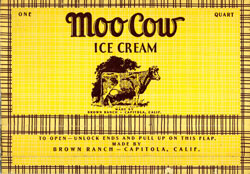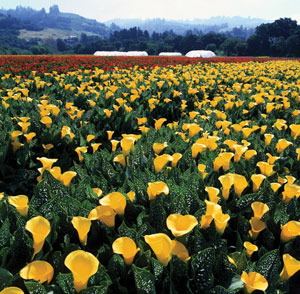1/26/2011
Centennial Celebration: From Cows to Callas
Tom Lukens
For 100 years now, Golden State Bulb Growers has been in the flower seed and bulb production business. The inception began with the Brown Ranch, then evolving to West Coast Horticulturists, then again to Brown Bulb Ranch, and finally to Golden State Bulb Growers in the 1980s.
The firm has become the world’s premier supplier of
Zantedeschia aestivae (also called
Z. sprengeri) hybrids—colored mini callas—offering these under the registered trademark of “Callafornia Callas.” Additionally, the firm extends its portfolio with
Zantedeschia aethiopica spp. and hybrids “Callafornia Divas,” “AmeriHybrid” tuberous begonias,
Eucomis spp. “Aloha Lily” and
Scilla peruviana hybrids “Caribbean Jewels.” Golden State Bulb Growers is a vertically integrated company, hybridizing and producing millions of these bulbs annually for sales around the world.
The Brown’s Cows
Golden State Bulb began in 1911 when James Brown purchased five acres of barren land outside the small coastal California town of Capitola. Because the ground had been sapped of its nutrients by 50 years of wheat production, James decided to purchase a herd of registered Guernsey cattle from a local judge. He built a dairy and kept the cattle in corrals, feeding them only weed-free feeds, the bi-product of which was an abundance of weed-free fertilizer. Always innovative, James even packaged and sold this composted manure under the name of West Coast Horticulturists’ “Moo Cow Fertilizer.”

The Guernsey dairy flourished, and Moo Cow ice cream, candy and milk were distributed in their own regional retail stores. Through contracts with the Southern Pacific Railroad, Dollar Line Cruise Ships, Panama Pacific, Matson Australian Lines and others, the reputation of Moo Cow milk and ice cream grew to even reach distribution in the Republic of Panama. At the peak of the dairy’s popularity in 1931, more than 9,000 visitors came to the company’s annual October Open House in Capitola. Always aware of advertising opportunities, the first Miss California was also photographed at the Brown Ranch alongside the dairy’s prize milk cow.
Enter Flowers
In the early 20th century, freesias were still an experimental crop. Yet by 1916, James was growing more than 40 acres of freesias, gladiolas, montbretias, tulips and tuberose on newly acquired ground in the Capitola area. Later, 50 additional acres were acquired in Monterey County, where sweet pea, nasturtiums and other flower seeds were raised. Thousands of pounds of sweet pea seed alone were grown and shipped to English and Scandinavian seed houses in the 1920s.
Because he was always in search of new crops, the first calla lilies were acquired in 1915 and the first selection of today’s Callafornia Calla hybrids began. Early references, such as the Brown Bulb Ranch 1935 Trade List, shows that by 1935 the company already had been producing callas for over 20 years. And, what was stated there is still true: “By proper growing and curing we assure you of the finest results.”
Continuing the expansion, in 1924 James built 24,000 sq. ft. of glass house and seven acres of lath house for the propagation of tuberous begonias and gloxinias.
Stewarded by the second generation’s involvement beginning in 1928, new larger-flowered (up to 10 in. in diameter) and fully double upright tuberous begonias were introduced, as well as the first truly double hanging basket and picottee begonias. As a result of the Brown family’s success with begonias, as well as that of other local firms, in 1954 the Capitola Businessmen’s Association proclaimed Capitola the “Begonia Capital of the World.” Now exclusively supported by Golden State Bulb Growers, the Capitola Begonia Festival still continues and is held on the first weekend after Labor Day each year.
Brown Bulb Ranch survived the depression years by greatly expanding its client base with new distributor customers on the East Coast and elsewhere. By 1960, the marketing efforts of the second generation succeeded in getting flower bulbs into the first-ever national chain in the U.S., Woolworth’s. Woolworth was the first such national chain to offer packaged flower bulbs, and their success led to Sears & Roebuck also offering the company’s full line of packaged bulbs within a few years.
Callas reign
Colored mini callas overtook begonias as GSBG’s primary crop more than 27 years ago. From the first humble pot types derived from South African species, to modern, long-lasting multi-flowered hybrids for small to large pots and cut flower production, Golden State’s Callafornia Callas have helped launch an entirely new horticultural crop for our industry. Cultural education, developmental research, product quality, performance, uniformity and consistency, while paired with new variety introductions, have long been keys to Golden State’s success. Other successful series introductions in other genera, like their first new Aloha Lily Leia (a
Eucomis spp. hybrid) and Caribbean Jewels Sapphire Blue (a
Scilla peruviana hybrid), are also certain to earn space on greenhouse benches and retailers’ shelves.
Today known as Golden State Bulb Growers, the company has defied the odds of multigenerational business survival and is now led by fourth-generation family members, with one fifth-generation horticultural school graduate recently joining the firm, as well. From horse-drawn farming and hand grading to large mechanical harvesters and computerized visual scanning and storage equipment, the company has earned a respected place in North America’s history of horticulture.
All are invited to come celebrate GSBG’s 100th Anniversary during this year’s Spring Trials event from March 26 to April 1, or visit us at our booth at the Ohio Short Course in July.
GT
Tom Lukens is Senior Sales and Technical Consultant, and President Emeritus of Golden State Bulb Growers in Moss Landing, California.